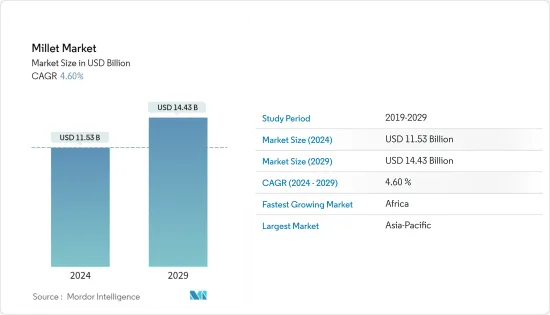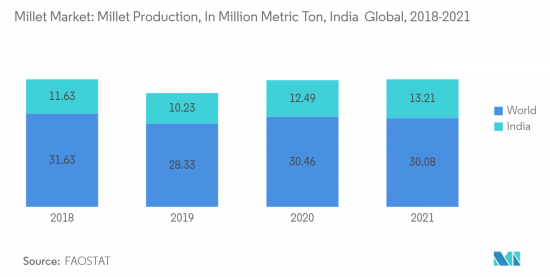 |
市場調査レポート
商品コード
1402985
雑穀:市場シェア分析、産業動向と統計、成長予測、2024~2029年Millet - Market Share Analysis, Industry Trends & Statistics, Growth Forecasts 2024 - 2029 |
||||||
● お客様のご希望に応じて、既存データの加工や未掲載情報(例:国別セグメント)の追加などの対応が可能です。 詳細はお問い合わせください。
価格
| 雑穀:市場シェア分析、産業動向と統計、成長予測、2024~2029年 |
|
出版日: 2024年01月04日
発行: Mordor Intelligence
ページ情報: 英文 82 Pages
納期: 2~3営業日
|
ご注意事項 :
本レポートは最新情報反映のため適宜更新し、内容構成変更を行う場合があります。ご検討の際はお問い合わせください。
- 全表示
- 概要
- 目次
概要
雑穀市場規模は2024年に115億3,000万米ドルと推定・予測され、2029年には144億3,000万米ドルに達し、予測期間中(2024-2029年)にCAGR 4.60%で成長すると予測されます。

主なハイライト
- 雑穀は、ソルガム、シコクビエ、トウジンビエ、オオヒエ、アワ、ヒエなどの様々な小粒穀物から成ります。乾燥地帯、半乾燥地帯、亜湿潤地帯の悪条件の多様な気候で、世界中で3,200万ヘクタール以上で栽培されています。インド、ニジェール、中国は世界最大の雑穀生産国で、世界の生産量の55.0%以上を占めています。インドは世界最大の雑穀生産国です。しかし近年、アフリカでは、水の利用可能性が低く、亜熱帯の気候条件が雑穀の生産に適しているため、多くの国が乾燥地での農業を奨励しており、雑穀の生産量は飛躍的に増加しています。
- これらの穀物は高タンパク質であるため、主に米国、欧州、アジア太平洋を拠点とするベジタリアンやビーガンの人々にとって理想的です。さらに、パンデミックは、多くの人々が食生活に雑穀を取り入れ、免疫力と健康を高めるためにジャンクフードから雑穀やその派生物のような栄養価の高い食品にシフトしていることから、市場にプラスの影響を与えています。したがって、これらの地域では雑穀をベースとした製品に対する需要が急速に伸びており、これが雑穀市場を牽引すると予想されます。
雑穀市場の動向
インドが世界の生産量を独占
- インドでは、栄養価の高い食事を作る上で雑穀が重要であることから、政府や団体が雑穀の生産を推進しています。その栄養価の高さから、雑穀はインド政府によってNutri-Cereals(栄養穀物)として認定されています。さらに、農業・農民福祉省(Department of Agriculture and Farmers Welfare:DA&FW)は、雑穀の栽培面積、生産量、生産性を向上させるため、国家食料安全保障ミッション(National Food Security Mission)の下で栄養雑穀に関するサブミッションを実施しています。
- 国連食糧農業機関(FAO)によると、2019年の世界の雑穀生産量は2,833万トンと推定され、2021年には3,008万トンに増加します。インドは世界最大の生産国で、2021年の世界市場シェアは43.0%で、ソルガム(jowar)、トウジンビエ(bajra)、シコクビエ(ragi)、その他の雑穀が栽培されています。農業・農民福祉省によると、インドの雑穀生産量は2015-16年の1,452万トンから2020-21年には1,796万トンに増加しています。
- 国内生産の拡大が雑穀の輸出をさらに後押ししています。DGCI &S(Director General for Commercial Intelligence &Statistics)によると、インドの雑穀輸出量は2020-21年の147,501.08トンに対し、2021-22年には8%増の159,332.16トンとなり、国内の雑穀生産を押し上げると予想されています。さらに、インド政府は世界市場での需要増加により、雑穀の輸出を促進しています。
- 例えば、農業加工品輸出開発局(APEDA)は、UAE、インドネシア、米国、日本、英国、ドイツ、南アフリカ、オーストラリア、サウジアラビアなどの国々で、雑穀と雑穀製品の輸出を増やすための16のプログラムを計画しています。このように、世界市場における雑穀需要の高まりと、インドにおける国内生産の増加が、今後数年間の市場を牽引すると予想されます。

アフリカが世界の消費を支配
- アフリカは世界の雑穀生産と消費において最大の地域です。この地域は世界の生産量の55%以上を占め、次いでアジアの40%です。ニジェール、マリ、ナイジェリア、ブルキナ、スーダンを中心とするアフリカ諸国は、世界の雑穀消費量の40.0%以上を占めています。
- 雑穀はインドやアフリカのような発展途上地域に広く普及しており、食料と栄養の安全保障が重要な課題となっています。干ばつに強い作物であるため、アフリカの半乾燥地帯では高い生産性を誇っています。そのため、同地域の気候変動と食糧安全保障の課題に対する解決策として、雑穀栽培の促進に向けた取り組みが行われています。
- 2021年5月、アフリカでは政府がコミュニティシードバンク、種子フェア、農民ネットワークを通じて雑穀の生産と消費を支援する政策を導入しました。公的および民間投資は、雑穀の種子開発と生産に限定されています。
- 雑穀の国際価格は非常に不安定で、供給量によって大きく左右され、通常、トウモロコシ、ソルガム、大麦などの他の主要粗粒穀物の価格とは無関係です。したがって、この地域では気候や食糧安全保障の課題が増大しています。アフリカでは雑穀の生産と消費が増加し、雑穀市場を牽引すると予想されます。
その他の特典:
- エクセル形式の市場予測(ME)シート
- アナリストによる3ヶ月間のサポート
目次
第1章 イントロダクション
- 調査の前提条件と市場定義
- 調査範囲
第2章 調査手法
第3章 エグゼクティブサマリー
第4章 市場力学
- 市場概要
- 市場促進要因
- 市場抑制要因
- バリューチェーン/サプライチェーン分析
第5章 市場セグメンテーション
- 地域(生産量別分析、金額・数量別消費分析、金額・数量別輸入分析、金額・数量別輸出分析、価格動向分析)
- 北米
- 米国
- カナダ
- 欧州
- ドイツ
- イタリア
- 英国
- ロシア連邦
- アジア太平洋
- 中国
- インド
- 日本
- 南米
- ペルー
- アルゼンチン
- アフリカ
- アルジェリア
- マリ
- ナイジェリア
- ニジェール
- 北米
第6章 市場機会と今後の動向
目次
Product Code: 46677

The Millet Market size is estimated at USD 11.53 billion in 2024, and is expected to reach USD 14.43 billion by 2029, growing at a CAGR of 4.60% during the forecast period (2024-2029).
Key Highlights
- Millets comprise various small portions of cereal such as sorghum, finger millet, pearl millet, barnyard millet, proso millet, and little millet. They are cultivated in adverse and diverse climates in dry, semi-arid, and sub-humid agriculture areas in over 32 million hectares worldwide. India, Niger, and China are the largest millet producers in the world, accounting for more than 55.0% of global production. India is the largest producer of millet in the world. However, in recent years, millet production has increased dramatically in Africa as many countries encourage dryland agriculture due to low water availability and sub-tropical climatic conditions favoring millet production.
- The high protein content of these grains makes them ideal for the vegetarian and vegan population, primarily based in the United States, Europe, and Asia-Pacific. Furthermore, the pandemic has affected the market positively as many people are including millets in their diet and shifting from junk foods to nutrient-rich foods like millets and their derivatives to boost immunity and health. Hence, the demand for millet-based products is growing rapidly in these regions, which is anticipated to drive the millet market.
Millet Market Trends
India Dominates the Global Production
- The government and organizations promote millet production in India due to its importance in making a nutritional diet. Due to their nutritional value, millets are notified as Nutri-Cereals by the Government of India. Furthermore, the Department of Agriculture and Farmers Welfare (DA&FW) is implementing a sub-mission on nutri-cereals under National Food Security Mission to enhance the area, production and productivity of millets.
- According to Food and Agriculture Organization (FAO), global millet production was estimated at 28.33 million metric tons in 2019, which increased to 30.08 million metric tons in 2021. India is the largest global producer, with a 43.0% global market share in 2021 with Sorghum(jowar), Pearl Millet (bajra), Finger millet (ragi), and other minor millets are grown in the country. According to the Ministry of Agriculture and Farmers Welfare, millet production in India has increased from 14.52 million tonnes in 2015-16 to 17.96 million metric tons in 2020-21.
- The expanding domestic production has further boosted the export of millet. According to Director General for Commercial Intelligence & Statistics (DGCI & S), the millet exports in India rose by 8% to 159,332.16 metric tons in 2021-22 against 147,501.08 metric tons in 2020-21, which is anticipated to boost the local millet production. Furthermore, the government of India is promoting the export of millet due to rising demand in the global market.
- For instance, Agriculture and Processed products Export Development Authority (APEDA) has planned 16 programs for the promotion of millets and millet products in countries such as UAE, Indonesia, the United States, Japan, the United Kingdom, Germany, South Africa, Australia, Saudi Arabia, etc. to increase the millet exports of the country. Thus, the rising demand for millets in the global market and increased domestic production in India are anticipated to drive the market in the coming years.

Africa Dominates the Global Consumption
- Africa is the largest region in terms of global millet production and consumption. The region accounts for more than 55% of the global output, followed by Asia with 40%. African countries, mainly Niger, Mali, Nigeria, Burkina, and Sudan, hold more than 40.0% of the global millet consumption.
- Millets are prevalent in developing regions, like India and Africa, where food and nutritional security are significant challenges. The high drought tolerance capacity of the crop allows for its high productivity in the semi-arid areas of Africa. Therefore, efforts are being made to promote millet cultivation as a solution to the region's climate change and food security challenges.
- In May 2021, in Africa, governments introduced policies to support the production and consumption of millet via community seed banks, seed fairs, and farmer networks. Public and private investments are limited to millet seed development and production.
- International prices for millets are highly volatile, determined largely by supply volumes, and are usually unrelated to those of other major coarse grains, such as maize, sorghum, or barley. Thus, with growing climate and food security challenges in the region. Millet production and consumption are anticipated to increase in Africa, driving the millet market.
Additional Benefits:
- The market estimate (ME) sheet in Excel format
- 3 months of analyst support
TABLE OF CONTENTS
1 INTRODUCTION
- 1.1 Study Assumptions and Market Definition
- 1.2 Scope of the Study
2 RESEARCH METHODOLOGY
3 EXECUTIVE SUMMARY
4 MARKET DYNAMICS
- 4.1 Market Overview
- 4.2 Market Drivers
- 4.3 Market Restraints
- 4.4 Value Chain / Supply Chain Analysis
5 MARKET SEGMENTATION
- 5.1 Geography (Production Analysis by Volume, Consumption Analysis by Value and Volume, Import Analysis by Value and Volume, Export Analysis by Value and Volume and Price Trend Analysis)
- 5.1.1 North America
- 5.1.1.1 United States
- 5.1.1.2 Canada
- 5.1.2 Europe
- 5.1.2.1 Germany
- 5.1.2.2 Italy
- 5.1.2.3 United Kingdom
- 5.1.2.4 Russian Federation
- 5.1.3 Asia-Pacific
- 5.1.3.1 China
- 5.1.3.2 India
- 5.1.3.3 Japan
- 5.1.4 South America
- 5.1.4.1 Peru
- 5.1.4.2 Argentina
- 5.1.5 Africa
- 5.1.5.1 Algeria
- 5.1.5.2 Mali
- 5.1.5.3 Nigeria
- 5.1.5.4 Niger
- 5.1.1 North America
6 MARKET OPPORTUNITIES AND FUTURE TRENDS
お電話でのお問い合わせ
044-952-0102
( 土日・祝日を除く )
